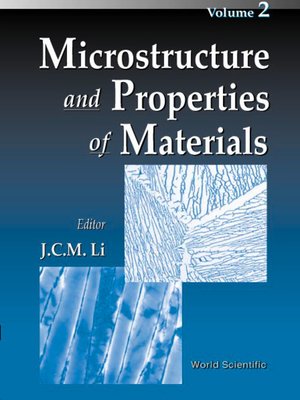
Sign up to save your library
With an OverDrive account, you can save your favorite libraries for at-a-glance information about availability. Find out more about OverDrive accounts.
Find this title in Libby, the library reading app by OverDrive.



Search for a digital library with this title
Title found at these libraries:
| Library Name | Distance |
|---|---|
| Loading... |
This is the second volume of an advanced textbook on microstructure and properties of materials. (The first volume is on aluminum alloys, nickel-based superalloys, metal matrix composites, polymer matrix composites, ceramics matrix composites, inorganic glasses, superconducting materials and magnetic materials). It covers titanium alloys, titanium aluminides, iron aluminides, iron and steels, iron-based bulk amorphous alloys and nanocrystalline materials.There are many elementary materials science textbooks, but one can find very few advanced texts suitable for graduate school courses. The contributors to this volume are experts in the subject, and hence, together with the first volume, it is a good text for graduate microstructure courses. It is a rich source of design ideas and applications, and will provide a good understanding of how microstructure affects the properties of materials.Chapter 1, on titanium alloys, covers production, thermomechanical processing, microstructure, mechanical properties and applications. Chapter 2, on titanium aluminides, discusses phase stability, bulk and defect properties, deformation mechanisms of single phase materials and polysynthetically twinned crystals, and interfacial structures and energies between phases of different compositions. Chapter 3, on iron aluminides, reviews the physical and mechanical metallurgy of Fe3Al and FeAl, the two important structural intermetallics. Chapter 4, on iron and steels, presents methodology, microstructure at various levels, strength, ductility and strengthening, toughness and toughening, environmental cracking and design against fracture for many different kinds of steels. Chapter 5, on bulk amorphous alloys, covers the critical cooling rate and the effect of composition on glass formation and the accompanying mechanical and magnetic properties of the glasses. Chapter 6, on nanocrystalline materials, describes the preparation from vapor, liquid and solid states, microstructure including grain boundaries and their junctions, stability with respect to grain growth, particulate consolidation while maintaining the nanoscale microstructure, physical, chemical, mechanical, electric, magnetic and optical properties and applications in cutting tools, superplasticity, coatings, transformers, magnetic recordings, catalysis and hydrogen storage.







